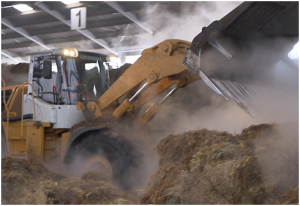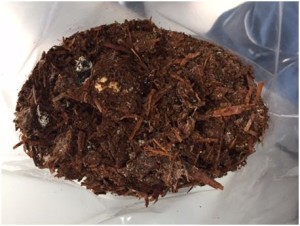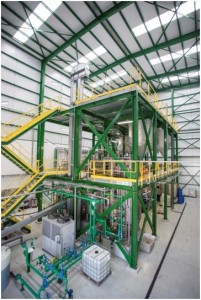Total fresh mushroom production in Europe amounts to approximately one million tons per year. For every tone of mushroom harvested, approximately three tons of mushroom compost is produced, which is currently collected from farms for a fee associated with transport and disposal, creating significant economic and logistical problems for farmers. This situation has led the mushroom industry to take advantage of the existing positive bioeconomy environment and to look for valorization alternatives for these residues to retrofit the current business into more sustainable and efficient activities.
The BIOrescue concept: novel bio-based products from mushroom compost

The BIOrescue project aims to develop and demonstrate a novel biorefinery concept based on the cascading use of mushroom compost supplemented by wheat straw (and other seasonal underutilized lignocellulosic feedstocks). This approach will avoid disposal costs and allow for the production of some biodegradable bio-based products and bioactive compounds, all the while helping to replace existing products based on fossil fuels.
BIOrescue will contribute to the extension of products’ lifecycles through the development of greater re-use and recycling processes as well as expanding business opportunities for mushroom farmers, and significantly increase the technical know-how and business opportunities of all the partners involved.
In a more detailed way, BIOrescue aims to obtain the following products:
- Bioactive compounds and a horticultural fertiliser directly extracted from mushroom compost.
- Highly efficient glucan-enzymes that can improve enzymatic hydrolysis of lignocellulosic feedstocks.
- Biopesticides that are naturally occurring bioactive substances, less toxic than conventional ones and very specific to the target pest.
- Nanocapsules, which are nanoscale shells made out of a nontoxic polymer membrane encapsulating an inner liquid. They have a myriad of uses, including medical applications for drug delivery, biopesticide encapsulation, food enhancement, nutraceuticals, and self-healing of materials.
The project is coordinated by CENER (Spanish National Renewable Energy Centre). The consortium includes the following European partners: Monaghan Mushrooms Ireland (technical coordinator), Università degli studi di Napoli Frederico II (UNINA), MetGen, Zabala Innovation Consulting, Max Planck Institute for Polymer Research (MPIP), Celignis, Imperial College of Science Technology and Medicine, C-Tech Innovation and Greenovate! Europe.
Monaghan Mushrooms has been working on the analysis of the aqueous phase for nutrient content and bioactive enzymes as well as producing and providing cellulases for the compost saccharification trials. Monaghan Mushrooms is currently involved in the enzymatic hydrolysis of spent mushroom compost at a medium scale for the optimization of the saccharification process.
Celignis is developing customized mathematical models that will allow the composition of biomass and the outputs of the BIOrescue technologies to be determined in seconds. These models only require that the samples be scanned using near infrared spectrophotometers, whereas the current standard methods of analysis involve several stages of chemical processing and require approximately 2 weeks to provide the same set of results. The models are being developed on wet, unprocessed, samples and will facilitate the development of systems for the rapid inline analysis of inputs and outputs within a biorefinery based on the BIOrescue process.

CENER has been working in the fractionation of mushroom compost, in combination with other agricultural residues, through the application of a two- step process based on the extraction of the soluble bioactive components and the thermochemical pretreatment of the insoluble fraction to get different side-streams to be used for the secondary conversion of the feedstock into different products.
MetGen has conducted an extensive screening of tailored enzymesolutions (MetZyme® SUNO™) together with hydrolysis conditions for the optimal saccharification efficiency of pre-treated biomasses. Depending on the type of the biomass and pre-treatment conditions, best enzyme formulations showed high reducing sugar yields and 80-100% glucan to glucose conversion ratios (compared to theoretical maximum). On top of the technical performance, aspects like processability and production cost of the enzyme cocktails have been considered, which will enable the selection of the most techno-economical feasible solution for the subsequent pilot-scale hydrolysis assays.
UNINA has selected one cellulase to be subjected to directed evolution by developing recombinant expression systems and characterising two new Streptomycescellulases of family GH5. The strategy for diversity generation and screening was set up using an automated workstation. This strategy was validated by applying it to generate and screen 5000 cellulase mutants and demonstrating that 6 of these new mutants show higher activity than wild type cellulase.
MPIP is developing a versatile and scalable approach for the large-scale synthesis of polymer nanocarriers from the soluble fraction obtained after thermochemical pretreatment. This method uses microfluidization to perform a controlled emulsification and was proven to be effective to prepare nanocarriers of different biopolymers (polysaccharides, lignin and proteins) up to 43g/min with reproducible size and distribution. Then biodegradable nanocarriers with different morphologies (solid nanoparticles, core-shell structures, porous nanoparticles) are being produced by a combination of miniemulsion polymerization and a solvent evaporation process. They may find useful application as novel drug delivery vehicle in agriculture or as carbon materials for water purification.

Imperial College London through the Centre of Environmental Policy is coordinating the Sustainability Assessment of the project. In collaboration with CENER, Imperial has started to define the methodology and environmental indicators to be used in a Life Cycle Assessment for the biorefinery. Imperial will be applying a Social Life cycle assessment and policy assessment and has already started to identify the stakeholders and indicators for the assessment. C-TECH has also started to identify the methodology and indicators for the economic assessment. The final sustainability integration of all issues will describe the most sustainable pathways among the value chains compared to all reference systems.
CENER’s Biorefinery and Bioenergy Pilot Plant
Besides being the project coordinator, CENER is using its biorefinery and bioenergy pilot plant to test and validate some stages of the new biorefinery concept (two-step fractionation and biopesticide production). This infrastructure includes several process development units focused on biomass pre-treatment, torrefaction, gasification and biochemical conversion. The different units can be used to testa wide variety of lignocellulosic biomass feedstocks and organic wastes for whole conversion processes with flexible configurations and scaling-up possibilities from pilot to semi-industrial.
This project has received funding from the Bio Based Industries Joint Undertaking under the European Union’s Horizon 2020 research and innovation programme under grant agreement No 720708.
Text by Inés del Campo (R&D Engineer, CENER Biomass Department), project coordinator on behalf of BIOrescue consortium.
More information: https://biorescue.eu/


